If you’re planning to visit Florida between March and October, you’ll have a great chance to witness a natural spectacle: sea turtle nesting season!
If you’ve never seen a sea turtle before, South Florida is the place to be. In fact, 90% of sea turtle nesting in the United States happens in the Sunshine State. Every year, the reptiles dig between 40,000 and 84,000 nests on Florida beaches.
From Pensacola to Panama City Beach—keep your eyes open during nesting season to encounter one of the oldest species on the planet as they come ashore to lay their eggs. If you don’t want to leave things up to chance, you can go on turtle walks led by conservationists and environmental groups.
Our guide will walk you through everything you need to know before you venture out to see the sea turtles. We’ve also created four fun, educational activities for your little ones that you can print out so they can learn more about sea turtles and how to protect them.
Table of Contents
- What Is Sea Turtle Nesting?
- How Can I Watch Sea Turtles?
- How Can I Protect Sea Turtle Nests?
- Where Are the Best Places to See Sea Turtle Nests?
- Conservancy Resources
- Printable Sea Turtle Activities
What Is Sea Turtle Nesting?
Sea turtles are reptiles and only come ashore to bask (raise their body temperature in the sun) and nest. The nesting process of a sea turtle is an interesting one which is why it’s such a popular attraction in South Florida. The female usually comes ashore during nighttime and tries to find a quiet and dark spot where she deems her eggs safe.
When she’s chosen a nesting site, she will dig a hole that can fit her entire body using all her four flippers. Once she’s fully submerged in her body pit, she’ll use her rear flippers to dig a chamber in which she’ll lay her eggs. Depending on the species, sea turtles lay between 50 (Flatback Turtles) and 200 ping pong-sized eggs (Hawksbill Turtles).
After the sea turtle has laid her eggs, she will fill both the egg chamber and the body pit with sand. Before the mother returns to the ocean, she will camouflage her nest, which is also called a clutch, by throwing dry sand on top of it to conceal the area. The whole process takes between 30 and 60 minutes.
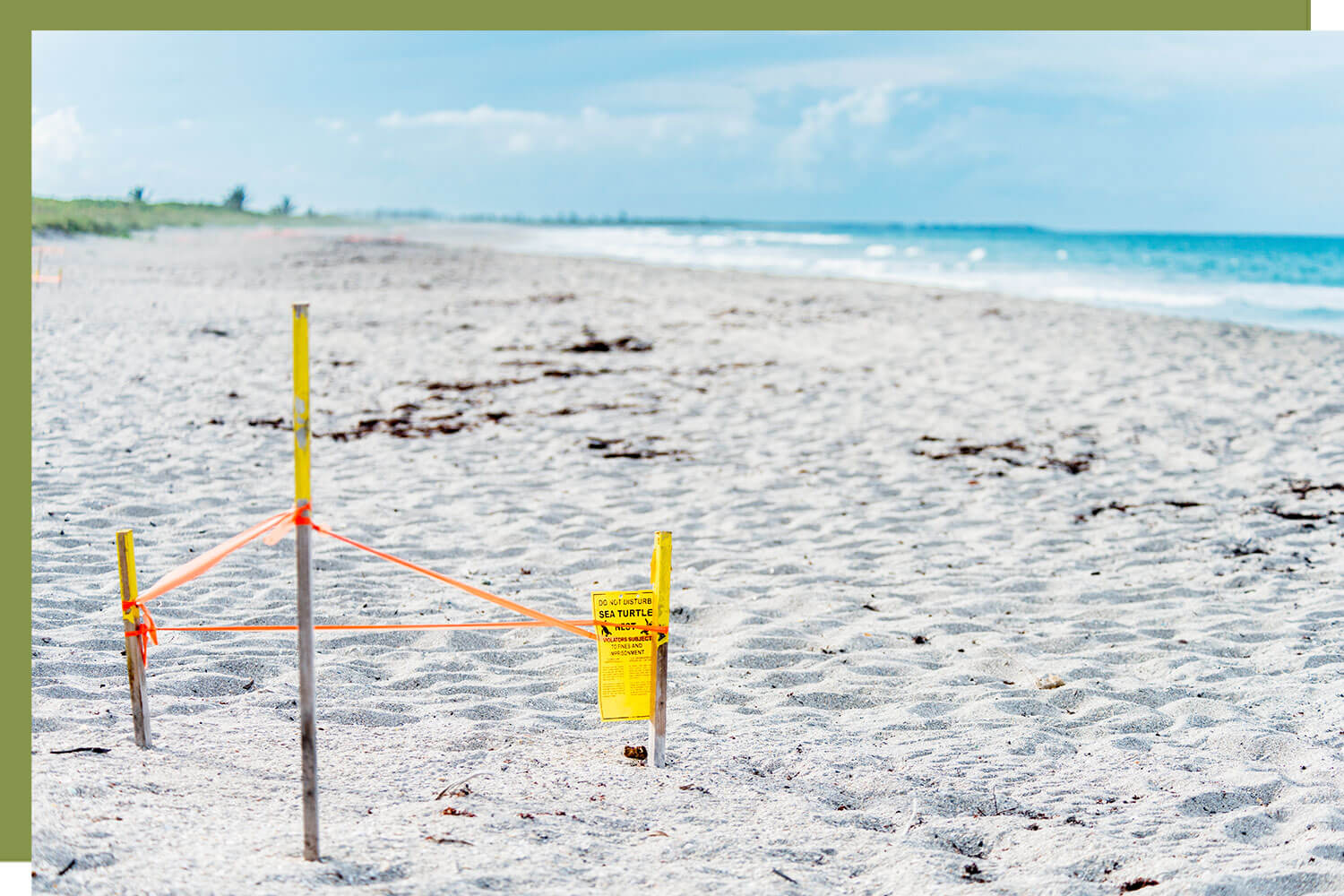
The eggs will incubate in their egg chamber for about two months before the hatchlings dig their way out and move to the ocean, where they will spend the majority of their lives.
The most common species of sea turtles in Florida are Leatherbacks, Loggerheads, Green Turtles, and one of the smallest, the Hawksbill. If you’re lucky, you may spot one of the rarest species during your stay, the Kemp’s Ridley.
Sea turtles have been around for over 100 million years and are a fundamental link in the marine ecosystem because they help maintain coral reefs and seagrass beds’ health. Because they’re an endangered species, it’s important to keep them safe.
How Can I Watch Sea Turtles?
If you’re in Florida during nesting season, you can go on a sea turtle walk with a local conservancy to witness this spectacle firsthand. Check online to see if nesting season is happening at your destination. Times can vary depending on the weather, water temperature, and location. For most of the Atlantic Coast, nesting season starts in March, if you’re visiting the Gulf Coast, you’ll likely have to wait until May to see sea turtles.
The tours generally allow anywhere from 20 to 40 people per group. Note that group sizes may be smaller due to Covid-19 restrictions. Before you head out to the beach, you’re required to attend an informational talk or session. Your guide will fill you in on a few facts about sea turtles and ensure that everyone in the group knows what to expect and how to act around the reptiles.
Prices for walking tours range from free to $20 or more per person. Most organizations open their registration between early March and May. Since spots can fill up quickly, it’s advised to book your tickets in advance. If you have to cancel your reservation, you usually won’t receive a refund. But the proceeds go to support the organization’s research and conservation efforts.
Here are a few things you should consider before booking a turtle walk:
- Tours typically take place at night time.
- Some tours have age restrictions, so check these ahead of time if you want to bring the family along.
- You’ll have to walk about a mile in the sand to get to your destination and back.
- A sea turtle takes between 30 to 60 minutes to lay her eggs, so the whole tour may last up to three hours.
Because the sea turtles can easily be disturbed, it’s important to look for a guided tour. Turtle walk guides know the federal and state laws and can provide an experience that’s both educational for the group and safe for the sea turtles. They also have a better understanding of where you’ll find sea turtle nests. While you’re not guaranteed to see them during the tour, your chances are much better during an official sea turtle walk.
During the tour, make sure to follow your guide’s instructions. To lay their eggs in peace, the sea turtles need space, quiet, and darkness. Sea turtle moms prefer dark places to nest that aren’t too close to the water and provide their eggs a safe environment. Flashlights, photography, or other light sources (like your phone’s LCD screen) can disorient or disturb mom turtles. This can cause her to lay her eggs in a less-than-optimal spot, giving her babies a slimmer chance of survival.
Here are a few essentials you should carry on your sea turtle walk to have a great experience and keep the turtles safe:

- Comfortable shoes: Remember that you’ll be walking in the sand for at least a mile to get to the sea turtle nest and then another mile to get back home. Wear shoes that are comfortable on long walks and that are okay to get wet.
- Dark clothing: To avoid disturbing the turtles and stay warm at night, wear dark long sleeves and pants. They can also prevent bug bites.
- Bug spray: Because Florida weather is so humid, mosquito season lasts all year. During the summer months, they thrive the most because temperatures tend to stay above 50 degrees Fahrenheit, so make sure you’re prepared!
- Water: Carry enough water for yourself and your family. You’ll be thankful to have something refreshing after your hike through the sand. If you can, bring reusable or recyclable water bottles and make sure to not leave them at the beach.
- Snacks: Since the tour can get quite lengthy, you may want to have some snacks with you. Ask ahead if you’re allowed to bring anything to the beach and if you do, have a bag or container to carry your trash back home.
- Raincoat or poncho: Rain season typically lasts from May through October. Wear rainproof clothing like a coat or a poncho and ask your guide if umbrellas (in dark colors) are allowed on the tour.
On your walk, you’ll likely see a Loggerhead turtle since it’s the most common species in Florida. Tour guides will avoid showing Leatherback or Green Turtle clutches because these species nest in smaller numbers. Conservationists also try to protect them from disturbances so their population can recover in the future.
If you happen to see a nesting sea turtle while you’re not on a guided tour, be extra careful not to disturb the mom. Stay quiet, eliminate any light sources, and carefully walk away so she can lay her eggs in peace.
How Can I Protect Sea Turtle Nests?
After the sea turtle mother buries her eggs, she returns to the ocean. Her eggs are left to their own devices, but if all goes well, depending on the species, between 50 and 180 turtle babies will hatch after about two months.
Right after they’re born, sea turtle babies are about the size of a KitKat bar (2.5–3.5 inches long). They now have to make their way back into the ocean. Because it’s estimated that only one of 1,000 hatchlings reach adulthood, it’s vital to make their time in the nests and their journey to the ocean as peaceful as possible.
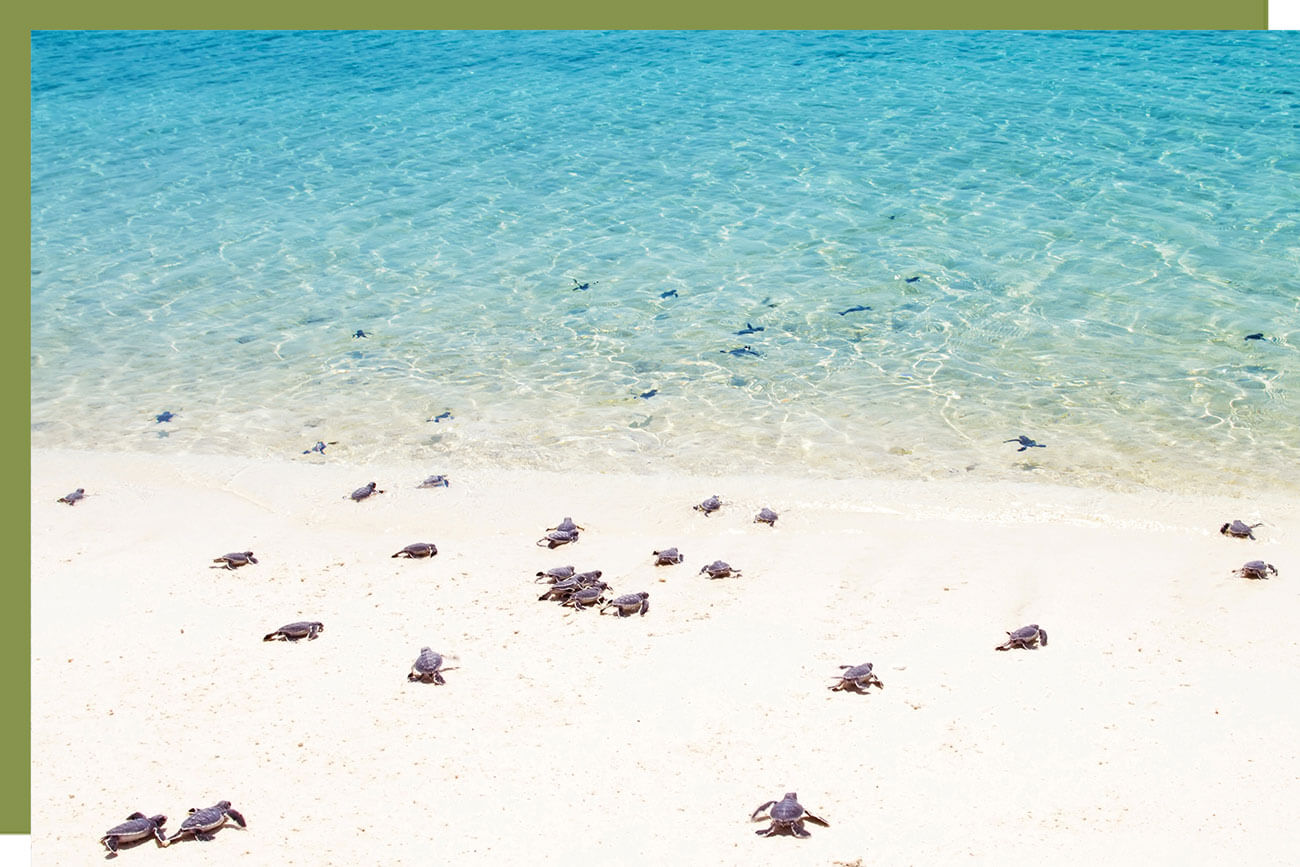
Undisturbed sea turtle clutches have a hatching success rate of up to 90%, but if the eggs can’t incubate in peace, those chances drop down to 25% or less. Here are a few tips on how you can protect the eggs and hatchlings and do your best to help them start a happy life in the big open sea.
- Watch your step: If you visit Florida during nesting season, March through October, keep an eye out for baby turtles walking on the sand, so you don’t accidentally step on them.
- Clean up after yourself: After your day of fun at the beach, knock down any sandcastles you built and fill up holes that you dug so the sea turtle moms or hatchlings don’t get stuck in them and can’t return to the ocean.
- Stay away from marked areas: Conservationists mark some nests to give the hatchlings a higher chance of survival. Don’t walk over these marked areas or put beach furniture close by so the eggs can incubate in peace.
- Bring it home: After closing out a beach picnic with friends or a family day at sea, make sure that any snacks, tents, or toys you brought return home with you or are properly disposed of. When you throw your trash out at the end of the day, close the lid, so predators like raccoons, birds, or other animals aren’t drawn to garbage cans on the beaches and end up eating the sea turtle eggs. If you live or stay close to the beach, don’t leave dog food out at night.
- Be respectful: Avoid fireworks or bonfires at night time. Both can disturb nesting turtle moms or hatchlings trying to find their way into the water.
- Follow the path: When you walk over sand dunes, stay on the designated paths. Sand dunes are a crucial buffer to protect homes from the sea and the beach from light pollution. They’re also the natural habitat of other creatures who deserve a safe and undisturbed home.
- Keep it dark: When you’re at the beach during nighttime, don’t use flashlights or flash photography. Sea turtles are drawn towards light over the water, so any light sources can disorient babies or the mom trying to get back into the ocean. Sea turtle hatchlings can end up on paths or the street and be trampled, killed, or run over. If you stay near the beach, close your drapes at night to minimize the chances of confusing the sea turtles.
- Call for help: If you spot a stranded, injured, or dead sea turtle, let someone know! You can call the Florida Fish and Wildlife Conservation Commission at 1-888-404-FWCC (3922) or alert a lifeguard. You can also report any harassment of nests or sea turtles to these sources.
How To Act Around Sea Turtles
If you happen to come upon a sea turtle nest or witness hatchlings making their way into the water first hand, remember that they’re protected by the Federal Endangered Species Act. Do not touch the eggs or the turtles and don’t directly help the hatched babies to the water. It’s vital for them to do this walk on their own so they can leave their imprint on the beach.
While you can do your best to keep their surroundings safe, it’s best to simply walk away when you find sea turtle babies, so they’re not disturbed by your presence.
How To Protect Sea Turtles In The Water
Finally, there are a few more ways in which you can keep sea turtles safe after they’ve made their way into the ocean. Inform yourself about coast guard approved boating guidelines and follow them. Keep thrush and line under way so that your trash doesn’t accidentally blow overboard. Sea turtles can ingest the garbage or get tangled in it, which can kill them. Wear polarized sunglasses to see any marine life in your path and avoid it if you can.
How To Volunteer Or Donate
If you want to donate or volunteer to help the sea turtles, see a few links below for sea turtle conservancies or conservation centers that you can support:
- Sea Turtle Conservancy
- Friends of South Walton Sea Turtles
- Navarre Beach Sea Turtle Conservation Center
- Panama City Beach Turtle Watch
Where are the Best Places to See Sea Turtle Nests?
Here are the best places to spot Loggerhead, Green Turtles, and Leatherback sea turtles in the Florida Panhandle during nesting season, May through October. Make sure to book a tour ahead of time to secure a spot for yourself and your family.
- Navarre Beach: You can check the Navarre Beach Sea Turtle Conservation Center website for more information on species, number of nests, and other updates on sea turtle activities on the beach.
- Eglin Beach Park: If you’re a military member or are considered DoD personnel, you can find sea turtles and their nesting spots at Eglin Beach. You can call (850) 882-7500 for more information.
- Destin-Fort Walton Beach: Visitors of the Destin-Fort Walton area can join complimentary nighttime turtle walks kicked off with a presentation by one of the local sea turtle experts. Tours are scheduled Tuesday and Wednesday night from June to October and can accommodate up to ten people per group. You can sign up for tours via email: [email protected].
- Panama City Beach: Turtle Watch, a group of volunteers, updates visitors of Panama City Beach on new turtle nests or hatchlings making their way to the water. Check out their regular updates to determine how your chances are to witness this natural phenomenon in person.
- St. George Island: From Eastpoint Beach, you can drive across the Bryant Patton Bridge to St. George Island, a top spot for watching sea turtles nest. The St. George Island Volunteer Turtlers share videos, pictures, and resources on their Facebook page to keep locals and visitors updated during sea turtle nesting season.
While all Florida beaches are potential nesting sites, the greatest concentration of Loggerhead turtles nesting lies on the East Coast. They can be found between the Canaveral National Seashore (Titusville) and Fort Lauderdale.
If you’re planning to travel around South Florida outside of the Panhandle, check out the list and links below for beaches, museums, and aquariums that are all about the sea turtles. Nesting season on the Atlantic Coast can start as early as March.
- Cape Canaveral National Seashore: The northernmost spot on our list to watch sea turtles is Cape Canaveral. The National Park is also home to Wood Storks, Bald Eagles, and West Indian Manatees, among others.
- Brevard County: Check for turtle walk availability guided by the Sea Turtle Preservation Society.
- Sebastian Inlet State Park: The Archie Carr National Wildlife Refuge has a sea turtle watch program. You can also check out the Sebastian Fishing Museum for more information on the State Park history and its wildlife.
- Jensen Beach: The Florida Power and Light Company has a sea turtle conservation program.
- Hobe Sound Nature Center
- Juno Beach: The Loggerhead Marine Life Center is one of Florida’s most visited nonprofit scientific destinations focused on sea turtle conservation.
- Barrier Island At Cape Florida: The Sea Turtle Conservancy offers turtle walks in June and July.
- Von D. Mizell-Eula Johnson State Park: Just south of the Everglades, this park is a popular location for fishing, swimming, boating, hiking, and other outdoor activities. Check for opening hours and restrictions during Covid-19.
- Florida Keys: You can get close to a threatened or endangered species of Florida sea turtles any day of the year by taking a tour of The Turtle Hospital in Marathon. This non-profit rehabilitation center rehabilitates sick and injured turtles.
- John D. MacArthur Beach State Park: This island is a haven for several rare or endangered species. Sea turtle walks were canceled in 2020, so check online for updates on the 2021 season.
- Fort Lauderdale: You can learn more about marine wildlife at the Museum of Discovery and Science. If you’d like to get a sneak peek of the museum, check out their virtual tour!
- Boca Raton: The Gumbo Limbo Nature Center has a sea turtle rehabilitation center, adoption, and conservation program. As of February 2021, the center is closed due to Covid-19 restrictions so check their website for updates.
- Sarasota: This city is located on the Gulf Coast. The Mote Marine Laboratory is a great place to learn more about sea turtles. If you want to go on turtle walks, check the areas between Longboat Key and Venice.
Conservancy Resources
The way you treat the beaches and the ocean is essential in making sure that this endangered species survives another 100 million years or longer. If you want to learn more about sea turtles and how to protect them, we have a few more resources that you can check out:
- WWF: Sea Turtles
- Sea Turtle Conservancy
- Florida Fish and Wildlife Conservation Commission
- Panama City Beach Turtle Watch
- SEE Turtles
Printable Sea Turtle Activities
To help your children understand how important it is to preserve wildlife and what they can do to be a sea turtle’s friend, we created these fun printables! Bring them along on your road trip or use them as a pastime when you’re taking an afternoon break from the beach.
Sea Turtle Hatchlings Maze
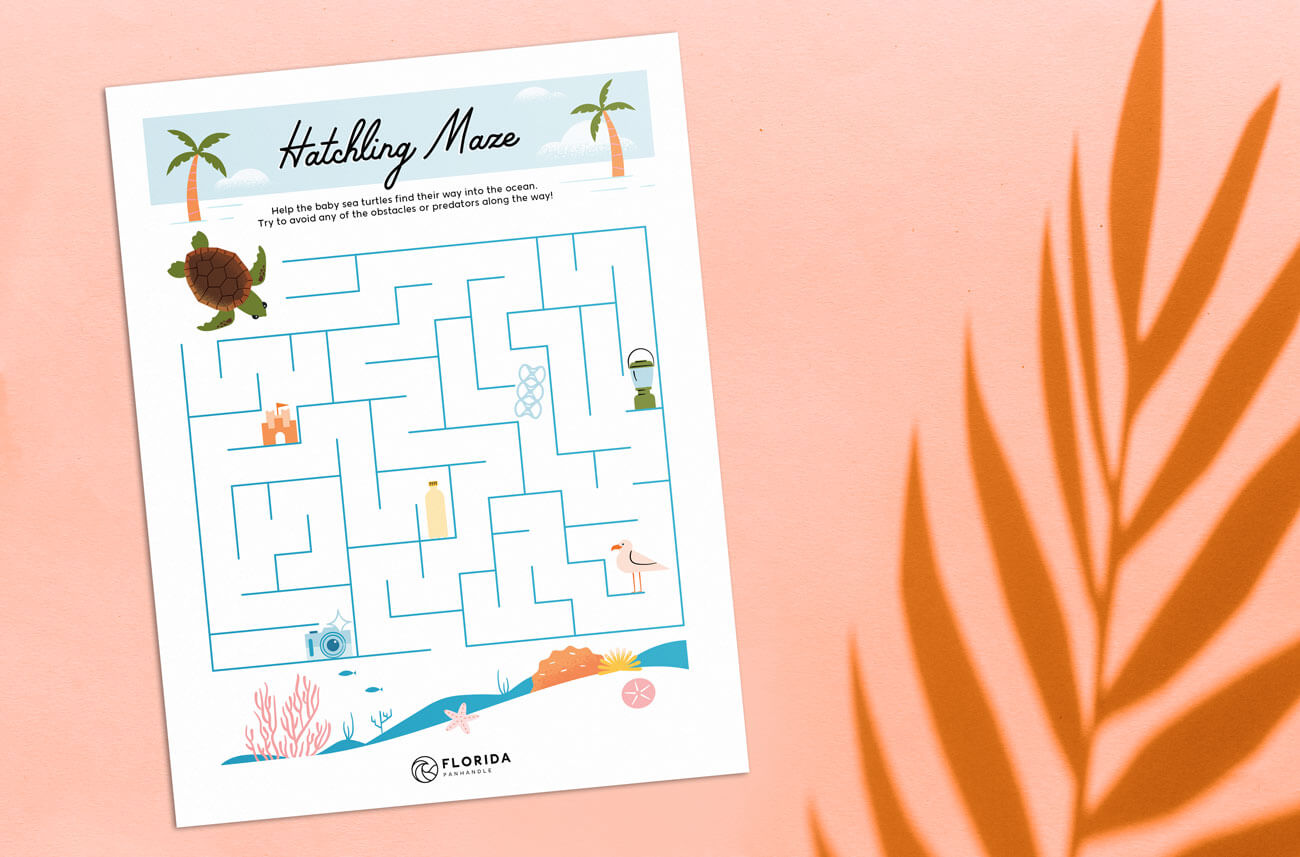
Guide the little hatchlings from their clutch (their nest) to the ocean so they can join their mom and become big sea turtles! Navigate through the maze and try not to run into any obstacles or predators along the way.

Sea Turtle Life Cycle Coloring Page
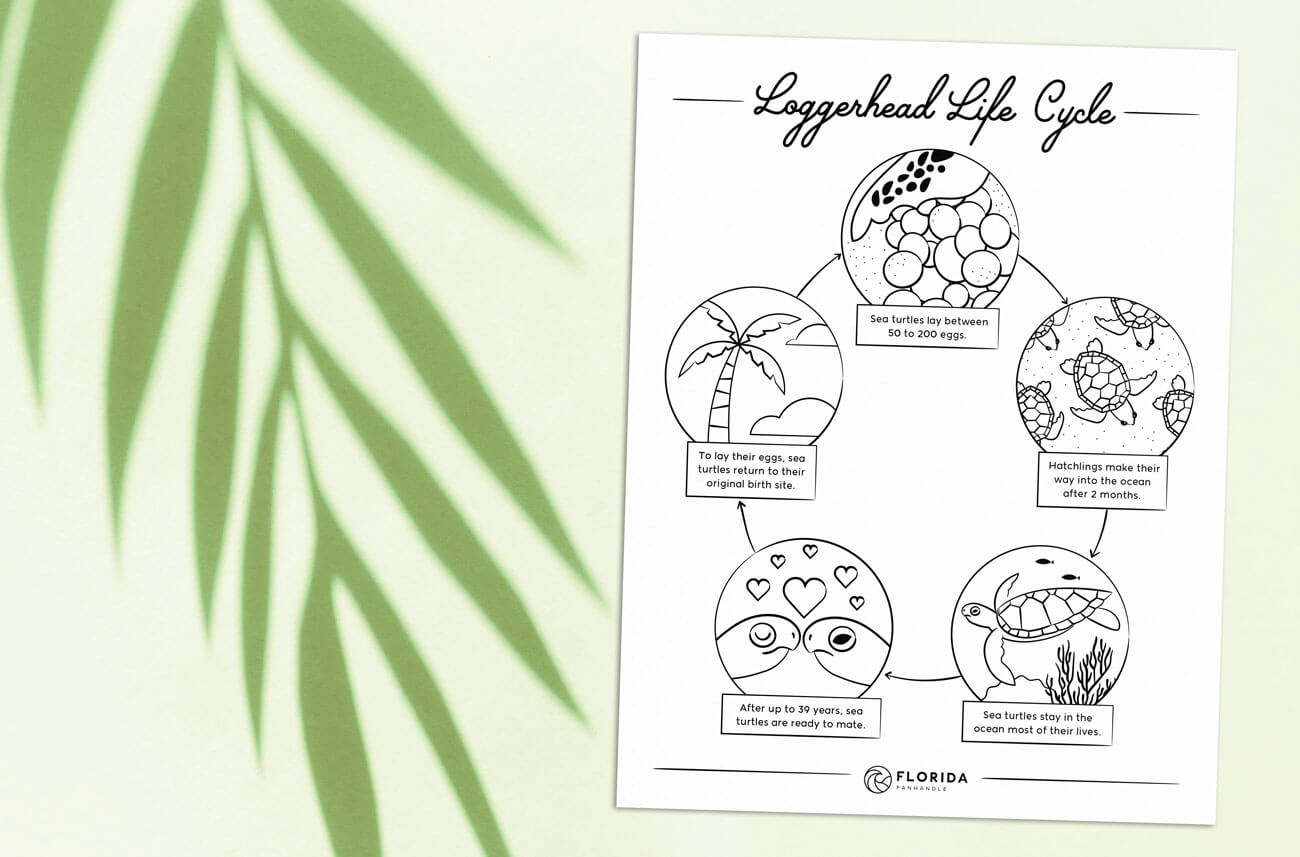
Who says learning new things has to be boring? Use your favorite pens to color the different life stages of a sea turtle: from eggs the size of ping pong balls to grown sea turtles as long as six feet (Leatherbacks).

Sea Turtle Friend Badges
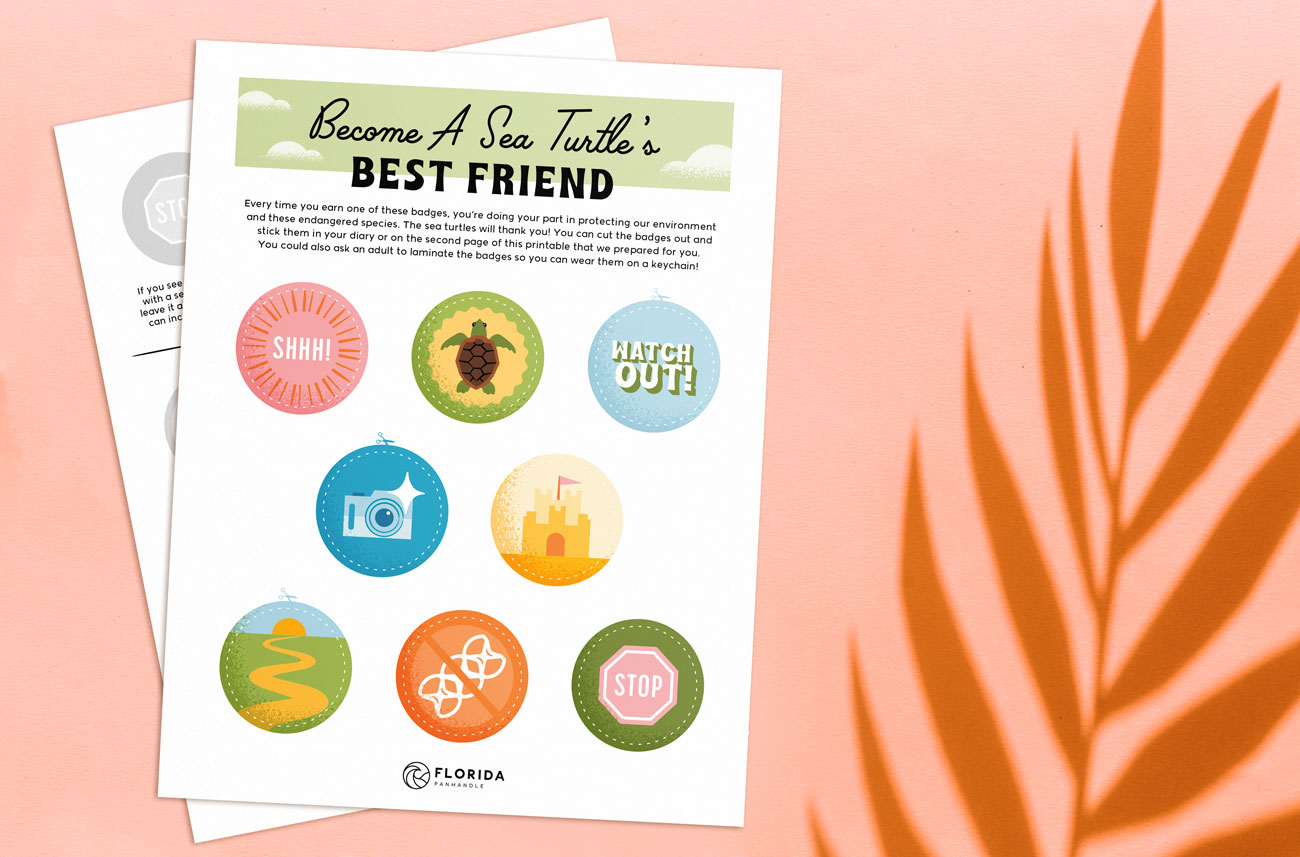
Collect all the badges to help preserve wildlife and become a sea turtle’s best friend. Every badge on this printable illustrates an essential step in keeping our beaches clean and the turtles safe from harm. Study them closely, collect them all, and do your best to protect the sea turtles! You can cut the badges out and paste them in your journal, on the second page of our printable, or ask an adult to laminate them so you can use them as keychains.

Sea Turtle Quiz
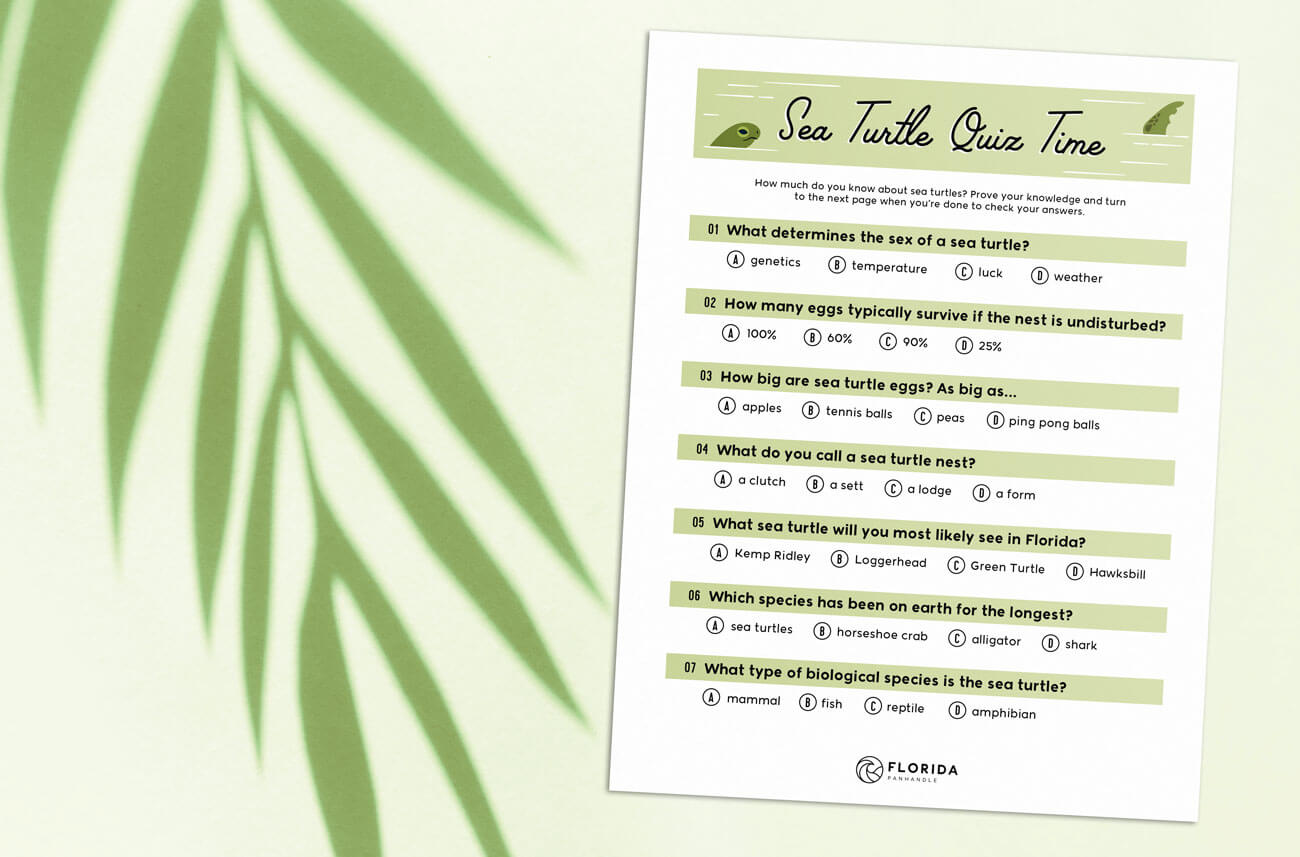
How much do you know about sea turtles? Take this little quiz to find out! Once you’ve completed the quiz, turn the page upside down to check if your answers were correct. If you got all of them right, that’s great and if you didn’t: Congratulations, you’ve learned something new!

If you’re staying in the Florida panhandle between May and October, going on a turtle walk is a fun and educational nighttime activity. Whether you look for turtles at Navarre Beach, Panama City Beach, or the Destin-Fort Walton area, we hope this guide helps you and your family protect and witness Florida wildlife.
Sources:
Visit Florida 1, 2 | Sea Turtle Conservancy | Florida Fish and Wildlife Conservation Commission | Turtle Watch




